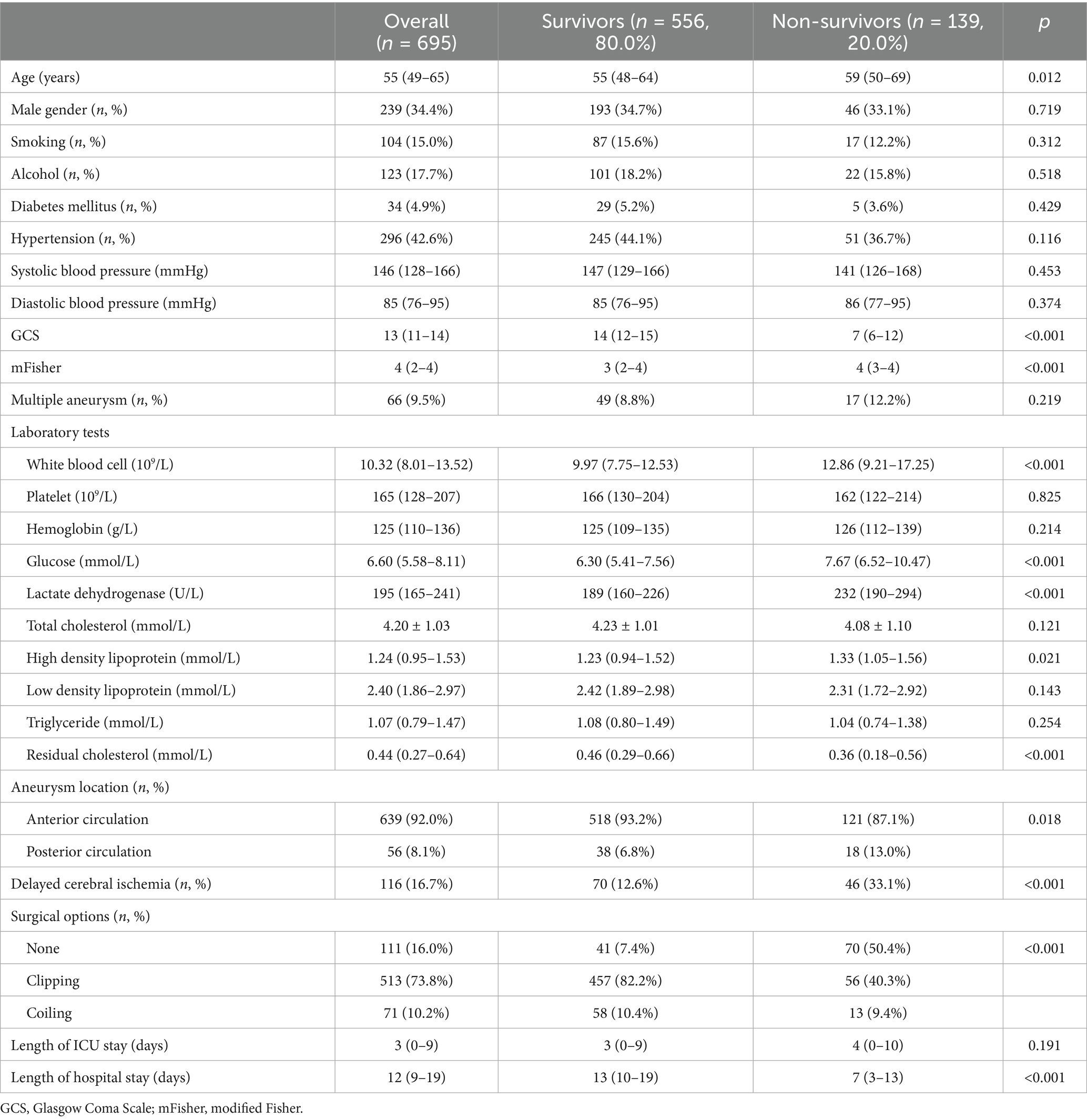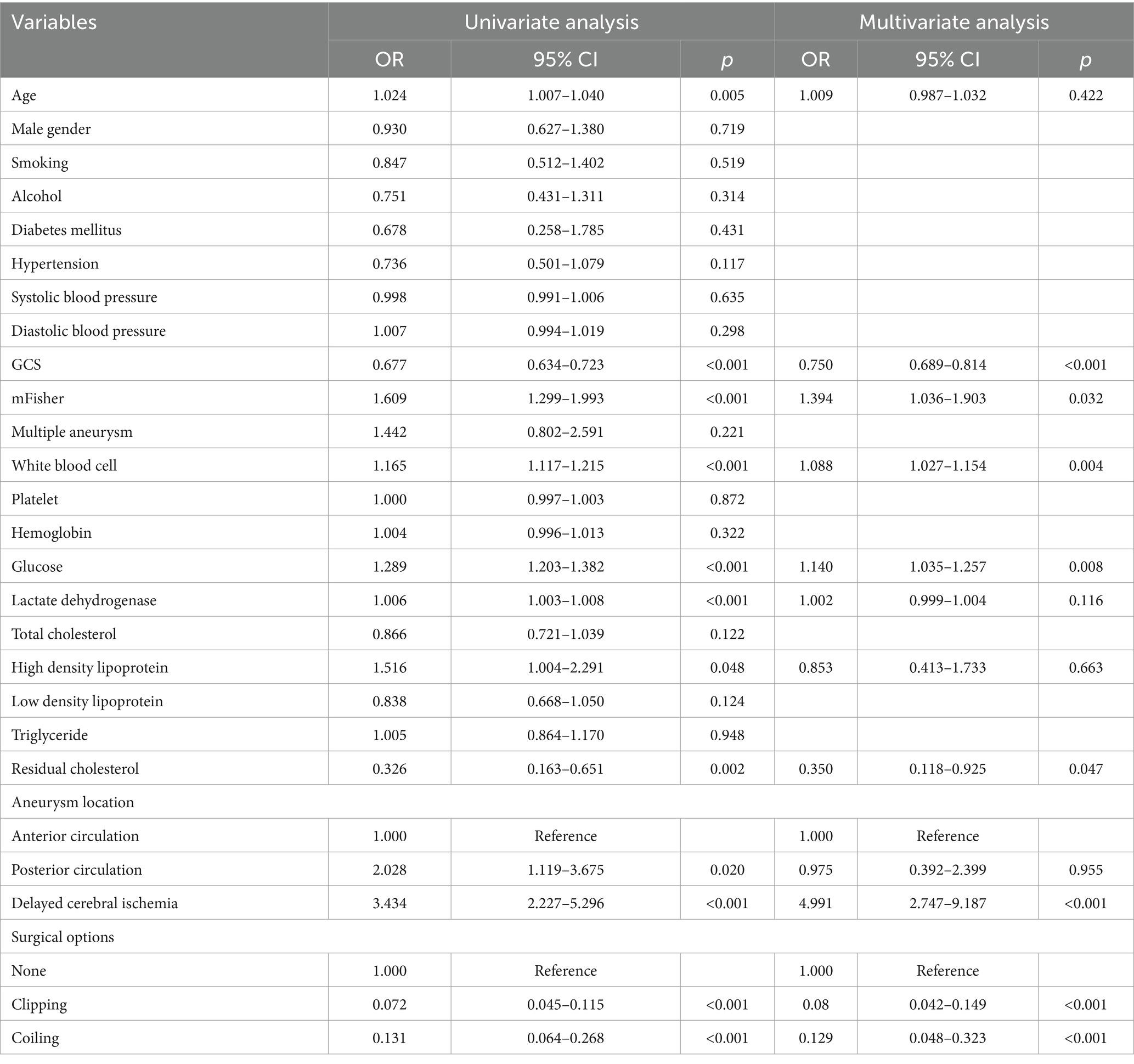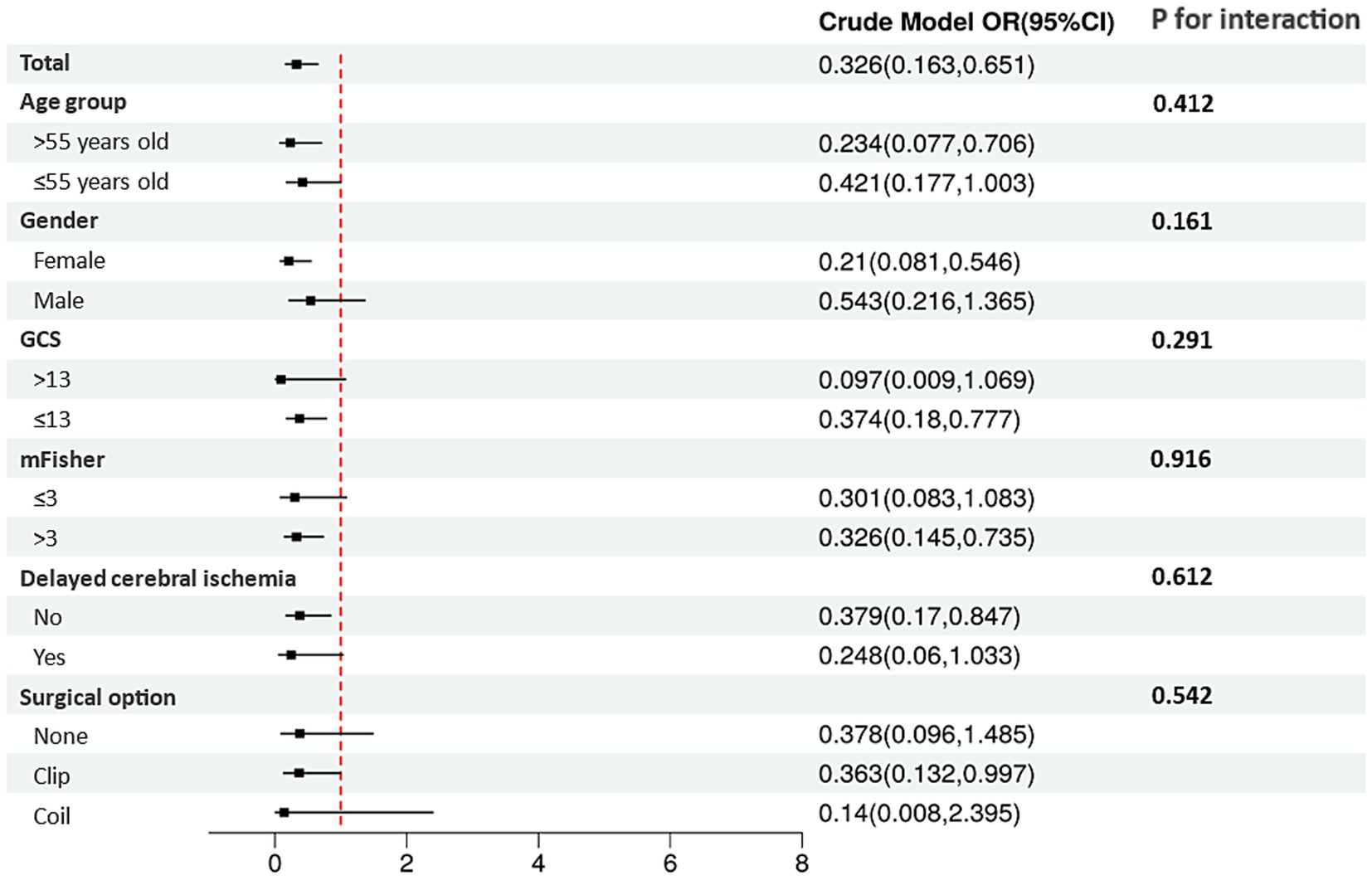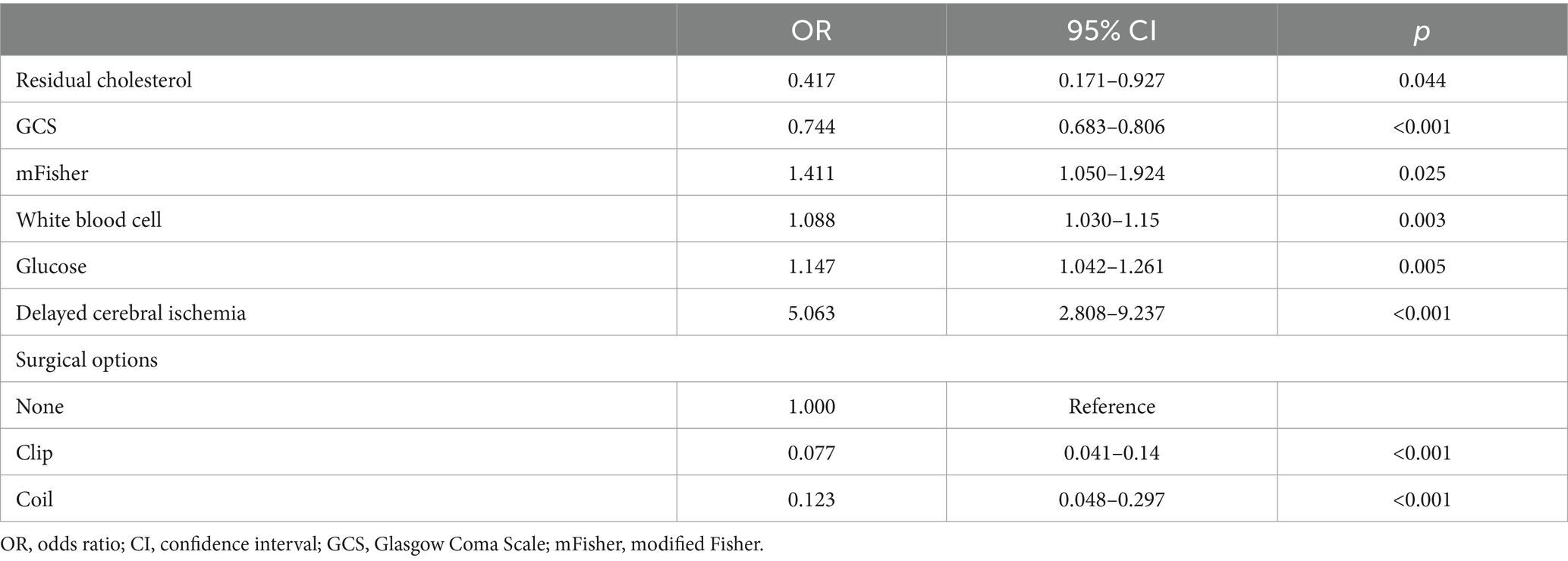- Department of Neurosurgery, West China Hospital, Sichuan University, Chengdu, China
Background: Residual cholesterol has been confirmed to be associated with the incidence of stroke and its prognosis. However, there is no study exploring the relationship between residual cholesterol and mortality in cases of aneurysmal subarachnoid hemorrhage (aSAH). Therefore, this study investigated the association between residual cholesterol levels and aSAH mortality.
Methods: A restricted cubic spline was used to show the relationship between residual cholesterol and mortality risk associated with aSAH. Univariate and multivariate logistic regression models were employed to identify independent risk factors for mortality. The independent risk factors identified in the multivariate logistic regression were combined to develop a predictive model for mortality risk. The receiver operating characteristic curve (ROC) was used to evaluate the predictive value of residual cholesterol and the developed predictive model.
Results: Among the aSAH patients included in the study, 20.0% experienced 30-day mortality. There were no significant differences in total cholesterol (p = 0.121), low-density lipoprotein cholesterol (p = 0.143), and triglycerides (p = 0.254) between survivors and non-survivors; however, high-density lipoprotein cholesterol (p = 0.021) was higher in non-survivors. Residual cholesterol (p < 0.001) was significantly lower among non-survivors. Multivariate logistic regression analysis revealed seven significant risk factors related to the mortality of aSAH including the Glasgow Coma Scale (GCS) (p < 0.001), modified Fisher Scale (mFisher) (p = 0.032), white blood cell count (p = 0.004), glucose levels (p = 0.008), residual cholesterol (p = 0.047), delayed cerebral ischemia (p < 0.001), and surgical options (p < 0.001). A predictive model for aSAH mortality was developed by combining these seven significant factors. The area under the ROC (AUC) for this predictive model was 0.911, while the AUC for residual cholesterol was 0.603.
Conclusion: Residual cholesterol is negatively associated with mortality risk in aSAH. Evaluating residual cholesterol is helpful in risk stratification of aSAH patients.
1 Introduction
Aneurysmal subarachnoid hemorrhage (aSAH) has an annual incidence of 9.1 cases per 100,000 individuals and is associated with a poor prognosis, with a mortality rate as high as 66.7% (1, 2). Risk stratification of aSAH severity at the early stage is beneficial for physicians, allowing them to adopt personalized treatments and improve the prognosis of aSAH. Some clinical scoring systems have been developed to assess the severity of aSAH, including the World Federation of Neurosurgical Society (WFNS) scale, the Hunt-Hess scale, and the modified Fisher scale (mFisher). Additionally, many biomarkers have been explored to predict the prognosis of aSAH, such as glial fibrillary acidic protein, copeptin, melatonin, interleukin-6, interleukin-33, nicotinamide adenine dinucleotide phosphate oxidase 4, cellular prion protein, and growth-arrest-specific protein 6 (3–10). These uncommon biomarkers are rarely measured in clinical settings, leading to higher medical costs. Attracting much attention from researchers, biochemical markers derived from routine blood examinations, such as the neutrophil-to-lymphocyte ratio, the neutrophil-to-albumin ratio, and the white blood cell-to-hemoglobin ratio, are widely explored due to low cost and practical convenience (11–13).
The lipid profile, a key component of blood biochemistry examinations, has garnered considerable interest from researchers because of its significant role in the development and progression of cardiovascular and cerebrovascular diseases (14–17). In addition to the traditional lipid profile, which includes total cholesterol, low-density lipoprotein cholesterol (LDL-C), high-density lipoprotein cholesterol (HDL-C), and triglycerides, some derived indicators have been developed, including residual cholesterol, calculated as total cholesterol minus the sum of HDL-C and LDL-C (18). Residual cholesterol has been confirmed to be related to the incidence and prognosis of ischemic stroke (19–21). There was no study exploring the association between residual cholesterol and the prognosis of aSAH. This study aimed to validate the correlation between mortality associated with aSAH and residual cholesterol levels.
2 Methods
2.1 Participants
aSAH patients who were treated in the West China Hospital (from January 2017 to June 2019) were enrolled in this retrospective study. The diagnosis of aSAH was confirmed through radiological signs observed on digital subtraction angiography (DSA) or computed tomography angiography (CTA). Some patients were excluded from the study based on specific criteria: (1) admission to our medical center 24 h after initial aneurysm rupture-related symptoms, (2) transfer from other hospitals, (3) incomplete records of the included variables, and (4) history of other neurological diseases such as stroke and central nervous system tumors. A total of 695 aSAH patients were finally enrolled in the study. The Ethics Committee of West China Hospital (2021–1,684) approved this retrospective study. Informed consent was obtained from patients or their legal representatives upon admission to our hospital.
2.2 Variables
Age, gender, smoking habit, alcohol consumption, and comorbidities, including diabetes mellitus and hypertension, were recorded. Systolic blood pressure and diastolic blood pressure were collected at admission. Clinical scoring systems, including the Glasgow Coma Scale (GCS) and the modified Fisher Scale (mFisher) scores at admission, were selected. Aneurysm-related information, including aneurysm location and multiple aneurysms, was identified based on radiological findings. Laboratory tests were collected within 4 h after admission, including white blood cell count, hemoglobin levels, platelets, triglycerides, total cholesterol, HDL-C, LDL-C, glucose levels, and lactate dehydrogenase. Residual cholesterol was calculated as total cholesterol-(HDL-C + LDL-C). Delayed cerebral ischemia was confirmed based on any one of the following two standards: (1) a dramatic decrease in the GCS score of ≥2 points (decrease in the total score or one component of the GCS, excluding other causes identified through clinical assessments and cerebral imaging) and (2) focal neurological impairment. Surgical options were classified into three categories: clipping, coiling, and no surgery, were classified. The primary outcome was set as 30-day mortality.
2.3 Statistical method
The normality of the variables was tested using the Kolmogorov–Smirnov test. Overall, patients were categorized into two groups: non-survivors and survivors. The difference in variables with normal distribution (expressed as mean ± standard deviation) and variables with non-normal distribution [expressed as median (interquartile range)] between non-survivors and survivors was verified utilizing the Student’s t-test and Mann–Whitney U-test, respectively. The difference in categorical variables [expressed as number (percentage)] was tested utilizing the chi-squared test. Spearman’s correlation analysis was performed to explore the relationship between residual cholesterol and other variables. A restricted cubic spline (RCS) was plotted to visually show the dose-dependent correlation between residual cholesterol and the mortality risk of aSAH. Significant risk factors for aSAH mortality identified through univariate logistic regression were validated in the multivariate logistic regression. The independent risk factors in the multivariate logistic regression were combined to develop a predictive model for mortality. Subgroup analyses were performed to evaluate the relationship between residual cholesterol levels and mortality risk, with additional testing for potential interaction effects across clinically relevant stratification variables. The receiver operating characteristic curve (ROC) was plotted to assess the predictive accuracy of residual cholesterol and the developed predictive model. A nomogram and calibration plots of the predictive model were plotted. All these analyses were conducted using R (version 4.3.2).
3 Results
3.1 Characteristics of enrolled aSAH patients
Among the aSAH patients included in the study, 20.0% experienced 30-day mortality (Table 1). Non-survivors were older (p = 0.012) with lower GCS (p < 0.001) and higher mFisher (p < 0.001) scores. No significant differences were observed between survivors and non-survivors in terms of gender distribution (p = 0.719), prevalence of smoking (p = 0.312), alcohol consumption (p = 0.518), or comorbidities including diabetes mellitus (p = 0.429) and hypertension (p = 0.116). Laboratory tests revealed that white blood cell count (p < 0.001), glucose levels (p < 0.001), and lactate dehydrogenase levels (p < 0.001) were higher among non-survivors. Total cholesterol (p = 0.121), low-density lipoprotein cholesterol (p = 0.143), and triglycerides (p = 0.254) were not different between survivors and non-survivors, while high-density lipoprotein cholesterol (p = 0.021) was higher among non-survivors. Residual cholesterol (p < 0.001) was significantly lower among non-survivors. Non-survivors were more likely to receive no surgical intervention for the ruptured aneurysm (p < 0.001). Finally, non-survivors had a shorter hospital stay (p < 0.001) but no difference in ICU stay length (p = 0.191) compared to survivors.
3.2 Correlation between residual cholesterol and aSAH mortality
Spearman’s correlation analysis revealed no significant association between residual cholesterol and either GCS score (p = 0.084, p = 0.027) or mFisher grade (p = 0.003, p = 0.935) (Table 2). RCS analysis showed linear and negative correlations between residual cholesterol and aSAH mortality (p < 0.001) (Figure 1). A total of 11 potential risk factors for aSAH mortality were identified through univariate logistic regression, including age (p = 0.005), GCS score (p < 0.001), mFisher grade (p < 0.001), white blood cell count (p < 0.001), glucose levels (p < 0.001), lactate dehydrogenase (p < 0.001), high density lipoprotein (p = 0.048), residual cholesterol (p = 0.002), posterior circulation (p = 0.020), delayed cerebral ischemia (p < 0.001), and surgical options (p < 0.001) (Table 3). Multiple logistic regression identified seven independent significant risk factors for aSAH mortality, including GCS score (p < 0.001), white blood cell count (p = 0.004), mFisher grade (p = 0.032), glucose levels (p = 0.008), residual cholesterol (p = 0.047), surgical options (p < 0.001), and delayed cerebral ischemia (p < 0.001). Although subgroup analyses revealed varying p-values across different strata, no statistically significant interaction effects were observed between residual cholesterol and age, gender, GCS score, mFisher grade, delayed cerebral ischemia, or surgical treatment options (all p-interaction > 0.05). The absence of detectable interaction effects may represent a type II error secondary to a limited sample size (Table 4; Figure 2).
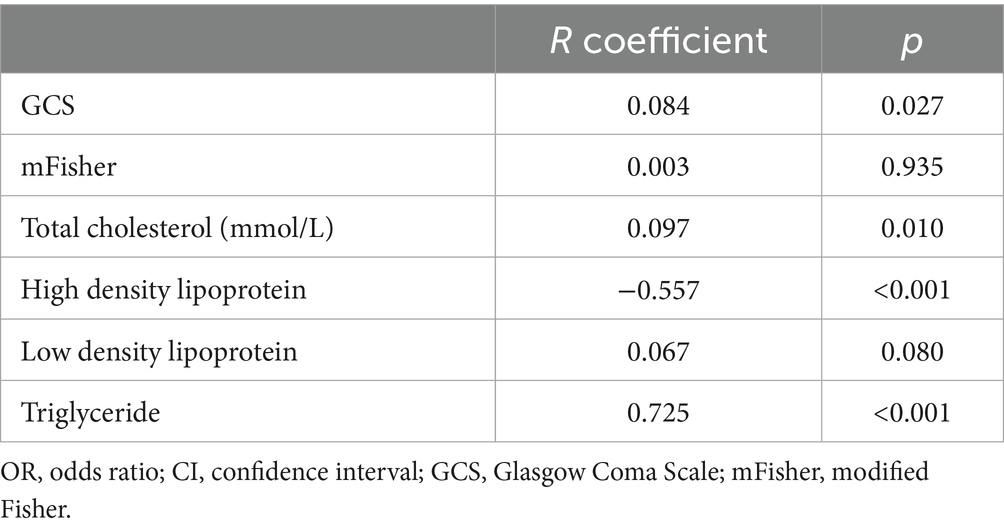
Table 2. Spearman correlation analysis between residual cholesterol and severity scores of aSAH patients.
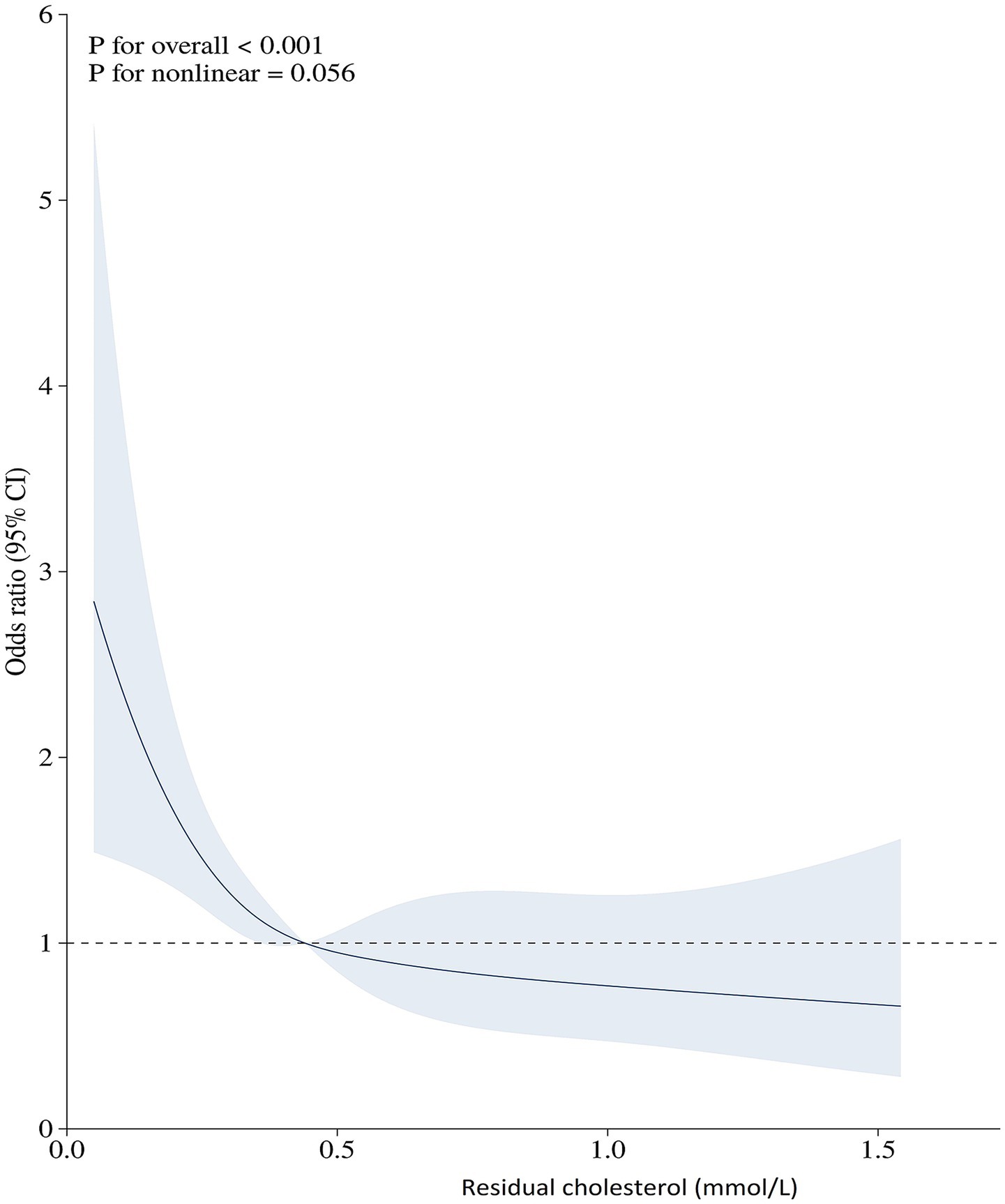
Figure 1. Relationship between residual cholesterol and aSAH mortality is shown by the restricted cubic spline.
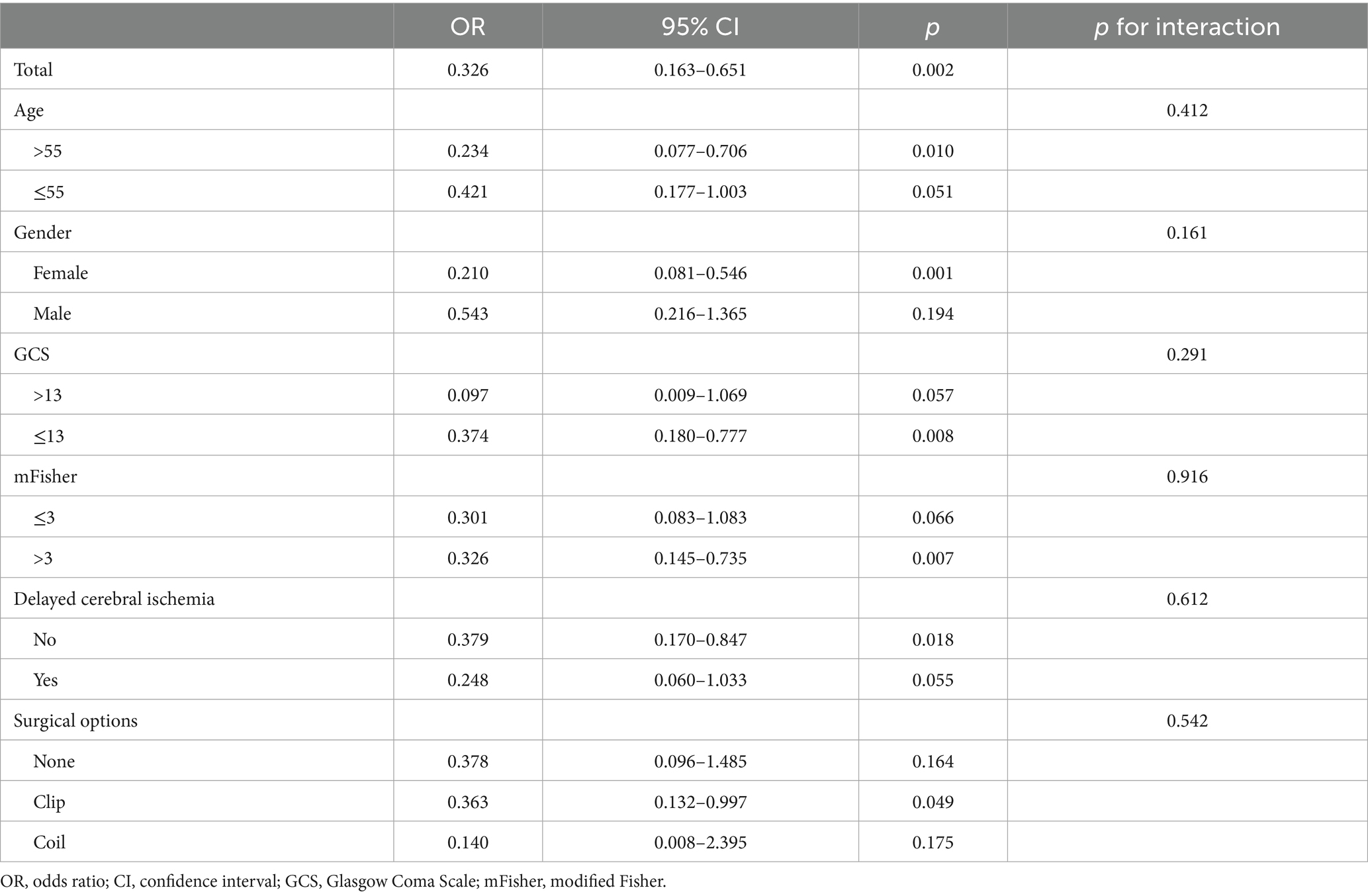
Table 4. Subgroup analysis for the association between residual cholesterol and the mortality of aSAH patients.
3.3 Prognostic value of residual cholesterol among aSAH
Seven significant factors from multivariate logistic regression were combined to develop the predictive model for aSAH mortality (Table 5). The predictive accuracy of residual cholesterol (AUC = 0.603) and the predictive model (AUC = 0.911) was evaluated using ROC analysis (Table 6; Figure 3A). The nomogram and calibration curve of the predictive model are presented in Figures 3B,C.

Table 6. The predictive value of residual cholesterol and the logistic model for the mortality of aSAH patients.

Figure 3. (A) Receiver operating characteristic curve of residual cholesterol for predicting mortality in aSAH patients. (B) Nomogram of the predictive model for mortality in aSAH patients. (C) Calibration plot of the predictive model for mortality in aSAH patients. GCS, Glasgow Coma Scale; mFisher, modified Fisher; AUC, area under the receiver operating characteristic curve.
4 Discussion
The lipid profile from this study showed that total cholesterol, LDL-C, and triglycerides were relatively lower in non-survivors of aSAH, although this difference was not statistically significant. Similarly, one study found that aSAH patients with unfavorable outcomes had lower levels of total cholesterol (22). This fact means that the cholesterol levels are a protective factor for the prognosis of aSAH. However, one previous study confirmed that higher levels of serum triglycerides and cholesterol were related to fewer occurrences of SAH (23). The protective effect of cholesterol and triglycerides on the outcome of aSAH has not been verified. HDL-C was higher among non-survivors of aSAH, indicating that high HDL-C may be a risk factor for aSAH mortality. One previous study showed that both low total cholesterol and low HDL-C were independent predictors of increased mortality and delayed cerebral ischemia in aSAH patients (24). Only 75 aSAH patients were included in the study. Additionally, HDL-C was not found to be significantly related to mortality in our multivariate logistic regression. The prognostic effect of HDL-C among aSAH patients deserves further exploration. Nevertheless, only residual cholesterol was finally identified as an independent factor for aSAH mortality in our multivariate logistic regression. Residual cholesterol was significantly higher in survivors of aSAH, indicating that increased levels of residual cholesterol were a protective factor for the prognosis of aSAH.
Residual cholesterol has been confirmed to be related to the incidence and prognosis of ischemic stroke (19, 20). One study showed that higher levels of residual cholesterol were related to an increased risk of ischemic stroke but not hemorrhagic stroke (19). Other studies also found that elevated levels of residual cholesterol were a risk factor for acute ischemic stroke (19, 25–27). Positive effects of elevated levels of residual cholesterol on outcomes for acute ischemic stroke patients were also confirmed (28, 29). In contrast, one study showed that increased levels of residual cholesterol were negatively related to parenchymal hemorrhage after endovascular treatment for acute ischemic stroke of the anterior circulation (30). Another study showed that a low residual cholesterol level was associated with bleeding events during the acute stage of ischemic stroke or transient ischemic attack (20). It appears that increased levels of residual cholesterol were related to a lower risk of hemorrhagic events. Similarly, our findings showed that higher levels of residual cholesterol were a protective factor for the prognosis of aSAH, which is a common type of hemorrhagic stroke.
Residual cholesterol primarily consists of the cholesterol found in intermediate-density lipoprotein, very-low-density lipoprotein, triglyceride-rich lipoproteins, and chylomicron remnants (31). High residual cholesterol levels are associated with persistent arterial wall inflammation after endothelial injury, leading to hyperproliferation of vascular smooth muscle cells and neointimal hyperplasia (32–34). Although residual cholesterol has been confirmed to promote atherosclerosis, the mechanisms behind the inverse relationship between residual cholesterol and the mortality risk of aSAH warrant exploration. Some potential mechanisms need further experimental verification. First, cholesterol is known to play a crucial role in maintaining the integrity of cerebral small blood vessels and the blood–brain barrier (35, 36). Low levels of cholesterol could cause increased permeability and leakage of these vessels (37). Research has confirmed that elevated blood–brain barrier permeability contributed to delayed cerebral ischemia pathogenesis and poorer neurological outcomes after aSAH (38, 39). Additionally, serum cholesterol could affect platelet aggregation and, therefore, may promote bleeding events (40). Bleeding volume was an independent risk factor for the poor prognosis of aSAH patients (41).
Several limitations of this retrospective study need to be mentioned. First, this observational study enrolled aSAH patients from a single center in Southwest China. Some ineligible patients were excluded from the study. As a result, selection bias may have occurred, and the findings should be verified in other medical centers with a more generalized population affected by aSAH. Second, residual cholesterol levels may be influenced by various comorbidities, such as hyperlipidemia, atherosclerosis, and drugs that affect blood lipid levels. The findings of our study should be verified in future research, adjusting for the confounding effects of these factors. Third, markers of endothelial injury, inflammation, oxidation, and atherosclerosis were not measured. Therefore, we were unable to confirm the correlations between residual cholesterol and these pathophysiological processes to discover the underlying mechanisms. Fourth, only the initial residual cholesterol levels was collected, and the subsequent levels were not measured. Changes in residual cholesterol during hospitalization may provide additional prognostic value for aSAH patients.
5 Conclusion
Higher levels of residual cholesterol is related to lower mortality risk of aSAH. Evaluating residual cholesterol is useful in the risk stratification of aSAH patients.
Data availability statement
The raw data supporting the conclusions of this article will be made available by the authors, without undue reservation.
Ethics statement
The studies involving humans were approved by Ethics Committee of West China Hospital (Approval number: 2021-1684). The studies were conducted in accordance with the local legislation and institutional requirements. The participants provided their written informed consent to participate in this study.
Author contributions
XZ: Conceptualization, Data curation, Formal analysis, Writing – original draft. RW: Data curation, Formal analysis, Writing – original draft. JX: Writing – review & editing.
Funding
The author(s) declare that no financial support was received for the research and/or publication of this article.
Conflict of interest
The authors declare that the research was conducted in the absence of any commercial or financial relationships that could be construed as a potential conflict of interest.
Generative AI statement
The authors declare that no Gen AI was used in the creation of this manuscript.
Publisher’s note
All claims expressed in this article are solely those of the authors and do not necessarily represent those of their affiliated organizations, or those of the publisher, the editors and the reviewers. Any product that may be evaluated in this article, or claim that may be made by its manufacturer, is not guaranteed or endorsed by the publisher.
References
1. de Rooij, NK, Linn, FH, van der Plas, JA, Algra, A, and Rinkel, GJ. Incidence of subarachnoid haemorrhage: a systematic review with emphasis on region, age, gender and time trends. J Neurol Neurosurg Psychiatry. (2007) 78:1365–72. doi: 10.1136/jnnp.2007.117655
2. Nieuwkamp, DJ, Setz, LE, Algra, A, Linn, FH, de Rooij, NK, and Rinkel, GJ. Changes in case fatality of aneurysmal subarachnoid haemorrhage over time, according to age, sex, and region: a meta-analysis. Lancet Neurol. (2009) 8:635–42. doi: 10.1016/S1474-4422(09)70126-7
3. Gyldenholm, T, Hvas, CL, Hvas, AM, and Hviid, CVB. Serum glial fibrillary acidic protein (Gfap) predicts outcome after intracerebral and subarachnoid Hemorrhage. Neurol Sci. (2022) 43:6011–9. doi: 10.1007/s10072-022-06274-7
4. Vlachogiannis, P, Hillered, L, Khalil, F, Enblad, P, and Ronne-Engström, E. Interleukin-6 levels in cerebrospinal fluid and plasma in patients with severe spontaneous subarachnoid Hemorrhage. World Neurosurg. (2019) 122:e612–8. doi: 10.1016/j.wneu.2018.10.113
5. Zheng, YK, Dong, XQ, Du, Q, Wang, H, Yang, DB, Zhu, Q, et al. Comparison of plasma Copeptin and multiple biomarkers for assessing prognosis of patients with aneurysmal subarachnoid Hemorrhage. Clin Chim Acta. (2017) 475:64–9. doi: 10.1016/j.cca.2017.10.009
6. Zhan, CP, Zhuge, CJ, Yan, XJ, Dai, WM, and Yu, GF. Measuring serum melatonin concentrations to predict clinical outcome after aneurysmal subarachnoid Hemorrhage. Clin Chim Acta. (2021) 513:1–5. doi: 10.1016/j.cca.2020.12.006
7. Gong, J, Zhu, Y, Yu, J, Jin, J, Chen, M, Liu, W, et al. Increased serum Interleukin-33 concentrations predict worse prognosis of aneurysmal subarachnoid Hemorrhage. Clin Chim Acta. (2018) 486:214–8. doi: 10.1016/j.cca.2018.08.011
8. Pan, J, Lao, L, Shen, J, Huang, S, Zhang, T, Fan, W, et al. Utility of serum Nox4 as a potential prognostic biomarker for aneurysmal subarachnoid Hemorrhage. Clin Chim Acta. (2021) 517:9–14. doi: 10.1016/j.cca.2021.02.007
9. Yao, H, Lv, C, Luo, F, and He, C. Plasma cellular prion protein concentrations correlate with severity and prognosis of aneurysmal subarachnoid Hemorrhage. Clin Chim Acta. (2021) 523:114–9. doi: 10.1016/j.cca.2021.09.010
10. Zhang, X, Hong, H, Wang, X, Xie, Q, Miao, L, and Zhang, L. Serum Gas6 contributes to clinical outcome after aneurysmal subarachnoid Hemorrhage: a prospective cohort study. Clin Chim Acta. (2022) 533:96–103. doi: 10.1016/j.cca.2022.06.016
11. Zhang, R, Liu, Z, Zhang, Y, Pei, Y, He, Y, Yu, J, et al. Improving the models for prognosis of aneurysmal subarachnoid Hemorrhage with the neutrophil-to-albumin ratio. Front Neurol. (2023) 14:1078926. doi: 10.3389/fneur.2023.1078926
12. Min, J, Zhao, Y, Wang, X, and Zhao, J. Associations of neutrophil to lymphocyte ratio and red cell distribution width on different days with the prognosis of aneurysmal subarachnoid Hemorrhage patients. Medicine. (2023) 102:e36021. doi: 10.1097/MD.0000000000036021
13. Shin, KW, Park, EB, Jo, WY, Lee, HC, Park, HP, and Oh, H. Association between high preoperative white blood cell-to-Hemoglobin ratio and postoperative symptomatic cerebral vasospasm in patients with aneurysmal subarachnoid Hemorrhage. J Neurosurg Anesthesiol. (2024) 37:216–24. doi: 10.1097/ANA.0000000000000977
14. Pascual-Oliver, A, Casas-Deza, D, Yagüe-Caballero, C, Arbones-Mainar, JM, and Bernal-Monterde, V. Lipid profile and cardiovascular risk modification after hepatitis C virus eradication. Pathogens. (2024) 13:278. doi: 10.3390/pathogens13040278
15. Kamon, T, Kaneko, H, Itoh, H, Okada, A, Matsuoka, S, Kiriyama, H, et al. Sex difference in the association between lipid profile and incident cardiovascular disease among young adults. J Atheroscler Thromb. (2022) 29:1475–86. doi: 10.5551/jat.63166
16. Tahir, A, Martinez, PJ, Ahmad, F, Fisher-Hoch, SP, McCormick, J, Gay, JL, et al. An evaluation of lipid profile and pro-inflammatory cytokines as determinants of cardiovascular disease in those with diabetes: a study on a Mexican American cohort. Sci Rep. (2021) 11:2435. doi: 10.1038/s41598-021-81730-6
17. Katzke, VA, Sookthai, D, Johnson, T, Kühn, T, and Kaaks, R. Blood lipids and lipoproteins in relation to incidence and mortality risks for Cvd and cancer in the prospective epic-Heidelberg cohort. BMC Med. (2017) 15:218. doi: 10.1186/s12916-017-0976-4
18. Mach, F, Baigent, C, Catapano, AL, Koskinas, KC, Casula, M, Badimon, L, et al. 2019 esc/Eas guidelines for the Management of Dyslipidaemias: lipid modification to reduce cardiovascular risk. Eur Heart J. (2020) 41:111–88. doi: 10.1093/eurheartj/ehz455
19. Han, M, Huang, K, Shen, C, Hongyue, H, Liu, F, Li, J, et al. Discordant high remnant cholesterol with Ldl-C increases the risk of stroke: a Chinese prospective cohort study. Stroke. (2024) 55:2066–74. doi: 10.1161/STROKEAHA.124.046811
20. Wu, Z, Zhang, H, Yi, X, Li, X, Li, X, Balmer, L, et al. Low remnant cholesterol and in-hospital bleeding risk after ischemic stroke or transient ischemic attack. J Am Heart Assoc. (2024) 13:e034307. doi: 10.1161/JAHA.124.034307
21. Yang, XH, Zhang, BL, Cheng, Y, Shun Kun, F, and Jin, HM. Association of Remnant Cholesterol with risk of cardiovascular disease events, stroke, and mortality: a systemic review and meta-analysis. Atherosclerosis. (2023) 371:21–31. doi: 10.1016/j.atherosclerosis.2023.03.012
22. Qi, H, Yang, X, Hao, C, Zhang, F, Pang, X, Zhou, Z, et al. Clinical value of controlling nutritional status score in patients with aneurysmal subarachnoid Hemorrhage. World Neurosurg. (2019) 126:e1352–8. doi: 10.1016/j.wneu.2019.03.100
23. Tokuda, Y, and Stein, GH. Serum lipids as protective factors for subarachnoid Hemorrhage. J Clin Neurosci. (2005) 12:538–41. doi: 10.1016/j.jocn.2004.07.021
24. Li, B, McIntyre, M, Gandhi, C, Halabi, M, Long, A, Van Hoof, A, et al. Low Total cholesterol and high density lipoprotein are independent predictors of poor outcomes following aneurysmal subarachnoid Hemorrhage: a preliminary report. Clin Neurol Neurosurg. (2020) 197:106062. doi: 10.1016/j.clineuro.2020.106062
25. Varbo, A, and Nordestgaard, BG. Remnant cholesterol and risk of ischemic stroke in 112,512 individuals from the general population. Ann Neurol. (2019) 85:550–9. doi: 10.1002/ana.25432
26. Wadström, BN, Wulff, AB, Pedersen, KM, Jensen, GB, and Nordestgaard, BG. Elevated remnant cholesterol increases the risk of peripheral artery disease, myocardial infarction, and ischaemic stroke: a cohort-based study. Eur Heart J. (2022) 43:3258–69. doi: 10.1093/eurheartj/ehab705
27. Li, H, Miao, S, Chen, L, Liu, B, Li, YB, and Duan, RS. Association and mediating mechanism between remnant cholesterol and first-ever stroke among the Chinese general population. Front Neurosci. (2023) 17:1161367. doi: 10.3389/fnins.2023.1161367
28. Li, M, Wang, M, Zhao, Y, Zhong, R, Chen, W, Lei, X, et al. Effects of elevated remnant cholesterol on outcomes of acute ischemic stroke patients receiving mechanical Thrombectomy. J Thromb Thrombolysis. (2024) 57:390–401. doi: 10.1007/s11239-023-02939-y
29. Tan, Z, Zhang, Q, Liu, Q, Meng, X, Wu, W, Wang, L, et al. Relationship between remnant cholesterol and short-term prognosis in acute ischemic stroke patients. Brain Behav. (2024) 14:e3537. doi: 10.1002/brb3.3537
30. Sun, J, Zhang, J, Xin, B, Ye, Z, Cai, Y, Lu, K, et al. Traditional and non-traditional lipid parameters in relation to parenchymal Hemorrhage following endovascular treatment for acute ischemic stroke in anterior circulation. Clin Interv Aging. (2024) 19:891–900. doi: 10.2147/CIA.S459884
31. Krauss, RM, and King, SM. Remnant lipoprotein particles and cardiovascular disease risk. Best Pract Res Clin Endocrinol Metab. (2023) 37:101682. doi: 10.1016/j.beem.2022.101682
32. Varbo, A, Benn, M, Tybjærg-Hansen, A, and Nordestgaard, BG. Elevated remnant cholesterol causes both low-grade inflammation and ischemic heart disease, whereas elevated low-density lipoprotein cholesterol causes ischemic heart disease without inflammation. Circulation. (2013) 128:1298–309. doi: 10.1161/CIRCULATIONAHA.113.003008
33. Wang, YI, Bettaieb, A, Sun, C, DeVerse, JS, Radecke, CE, Mathew, S, et al. Triglyceride-rich lipoprotein modulates endothelial vascular cell adhesion molecule (Vcam)-1 expression via differential regulation of endoplasmic reticulum stress. PLoS One. (2013) 8:e78322. doi: 10.1371/journal.pone.0078520
34. Heo, JH, and Jo, SH. Triglyceride-rich lipoproteins and remnant cholesterol in cardiovascular disease. J Korean Med Sci. (2023) 38:e295. doi: 10.3346/jkms.2023.38.e295
35. Thrift, A, McNeil, J, and Donnan, G. Reduced frequency of high cholesterol levels among patients with intracerebral haemorrhage. J Clin Neurosci. (2002) 9:376–80. doi: 10.1054/jocn.2002.1111
36. Wieberdink, RG, Poels, MM, Vernooij, MW, Koudstaal, PJ, Hofman, A, van der Lugt, A, et al. Serum lipid levels and the risk of intracerebral Hemorrhage: the Rotterdam study. Arterioscler Thromb Vasc Biol. (2011) 31:2982–9. doi: 10.1161/ATVBAHA.111.234948
37. Escudero-Martínez, I, Thorén, M, Matusevicius, M, Cooray, C, Zini, A, Roffe, C, et al. Association of Cholesterol Levels with Hemorrhagic transformation and cerebral Edema after reperfusion therapies. Eur Stroke J. (2023) 8:294–300. doi: 10.1177/23969873221148229
38. Zhang, C, Tang, W, Cheng, L, Yang, C, Wang, T, Wang, J, et al. Early and delayed blood-brain barrier permeability predicts delayed cerebral ischemia and outcomes following aneurysmal subarachnoid Hemorrhage. Eur Radiol. (2024) 34:5287–96. doi: 10.1007/s00330-023-10571-w
39. Russin, JJ, Montagne, A, D'Amore, F, He, S, Shiroishi, MS, Rennert, RC, et al. Permeability imaging as a predictor of delayed cerebral ischemia after aneurysmal subarachnoid Hemorrhage. J Cereb Blood Flow Metab. (2018) 38:973–9. doi: 10.1177/0271678X18768670
40. Fessler, MB, Rose, K, Zhang, Y, Jaramillo, R, and Zeldin, DC. Relationship between serum cholesterol and indices of erythrocytes and platelets in the us population. J Lipid Res. (2013) 54:3177–88. doi: 10.1194/jlr.P037614
Keywords: residual cholesterol, lipid profile, subarachnoid hemorrhage, intracranial aneurysm, mortality
Citation: Zeng X, Wang R and Xu J (2025) Reduced residual cholesterol is associated with increased mortality risk in patients with aneurysmal subarachnoid Hemorrhage: a retrospective study. Front. Neurol. 16:1595387. doi: 10.3389/fneur.2025.1595387
Edited by:
Giuseppe Castaldo, University of Naples Federico II, ItalyReviewed by:
Mathew John, Jubilee Mission Medical College and Research Institute, IndiaI. Nyoman Wande, Udayana University, Indonesia
Copyright © 2025 Zeng, Wang and Xu. This is an open-access article distributed under the terms of the Creative Commons Attribution License (CC BY). The use, distribution or reproduction in other forums is permitted, provided the original author(s) and the copyright owner(s) are credited and that the original publication in this journal is cited, in accordance with accepted academic practice. No use, distribution or reproduction is permitted which does not comply with these terms.
*Correspondence: Jianguo Xu, eHVqZ0BzY3UuZWR1LmNu
 Xihang Zeng
Xihang Zeng Ruoran Wang
Ruoran Wang Jianguo Xu
Jianguo Xu